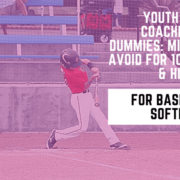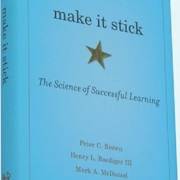Youth Baseball Coaching 101 For Dummies: Mistakes To Avoid For 10u, Middle, & High School
Discover youth baseball and softball coaching 101 for dummies. Learn what coaching mistakes to avoid for the 10u, middle school, and high school levels…
Coaching Baseball: Why We’re Failing
This article will highlight one of the scientific principles of successful learning, according to Peter C. Brown’s book Make It Stick. FYI, this will work for coaching softball as well.
In my research, I’ve uncovered THREE ingredients to coaching baseball:
- Study and apply scientifically proven human movement rules,
- Use sticky coaching strategies proven through empirical research, and
- Provide necessary feedback mechanisms to stay on track.
We’ll be attacking one of today’s major dilemmas in youth hitting – how do I take my players’ refined “batting practice” swings into the game? The problem is in how we train young hitters. We’ll talk about:
- The myth of “massed practice” to long-term learning,
- The fine art of variance as a teaching tool, and
- How-to INFUSE variance into hitting practices.
SCIENCE-BASED TRAINING:
Improve your hitting strategy dramatically by applying human movement principles.
Learn not only how and what to train but also the science behind the methods.
The Myth of “Massed Practice” to Long-Term Learning
What is “massed practice”? It’s when we work on one thing, say hitting to the opposite field – for an entire practice. For example, in Peter C. Brown’s book Make It Stick, he talks about an experiment the Cal Poly University baseball team ran. They split the hitters up into two practice groups. Group One did massed practice by hitting 15 fastballs, then 15 curve-balls, then 15 change-ups. Group Two practiced hitting each pitch at random. At the end of the experiment, Group One did better in the short run, while Group Two did better in the long run.
Why?
Because Group Two practiced how they’d play, and played how they’d practiced. We may gain immediate gratification from coaching baseball using massed practice, but we fall short in the long run, because hitting pitches in a game is so varied. We need to practice, what Peter C. Brown calls, variance when coaching baseball. It’s more frustrating this way, but the results are worth it.
The Fine Art of Variance
I know this might sound like a no-brainer. But it’s NOT. I’ve fallen victim to massed practice too! We’re taught to strengthen weaknesses. If a hitter has a hard time hitting to the opposite field, then dedicate a whole practice to opposite field hitting. The outcomes in batting practice are immediate, but as the empirical research says, the results are fleeting.
Another study mentioned in the book, split up a class of grade-schoolers into two groups. Group A practiced throwing beanbags into a bucket three feet away. Group B practiced throwing beanbags into two buckets, one 2-feet and another 4-feet away, and with NO 3-foot bucket. At the end, they were all tested throwing beanbags into a 3-foot bucket. Any guess who did better? Group B.
Why?
Their brain had more points of reference to pull from. “Throw a little farther than two, but less than four.” Whereas Group A had only one option.
How-To INFUSE Variance Into Hitting Practice
There are so many ways to do this, so I’ll only mention the few that have worked for my hitters. Here’s what coaching baseball using the variance hitting strategy looks like:
- Un-Weighting Part-1 – fix stride foot at Fight Position (watch video above for demonstration)
- Un-Weighting Part-2 – un-anchor back foot during Final Turn (watch video above for demonstration)
- Varied Pitches Off Batting Tee – after every swing move the tee either up or down, and/or pull side or opposite side setup (watch video above for demonstration). Rarely place ball over middle of the plate. As beanbag study suggests, if hitter can hit inside and outside pitch correctly, then they’ll be prepared to hit the pitch down the middle.
- Timing The Pitch – Every five swings or so move the L-Screen forward or backward to simulate a change in fast-to-slow pitching and vice-versa. I find that after footwork, timing is the next most difficult concept to master.
We’re failing as coaches because we aren’t mixing it up enough. Practice how you play, and you’ll play like you practice. Myself and the Hitting Performance Lab community would love to hear your thoughts on coaching baseball or softball using variance. Any other ideas? Please post below…
- Top Rated Online Softball Hitting Coaching: Improve Your Batting Average with Personalized Lessons - July 23, 2024
- Transform Your Coaching: Buy the Best Youth Baseball & Softball Culture Book for Effective Team Success - July 16, 2024
- Master Your Swing: How to Choose the Best Baseball Hitting Training Videos for Immediate Skill Boost - February 28, 2024








The position at impact of your student in the red jersey is a thing of beauty for such a young kid.
Thank you Matt! He’s been working hard for sure. This is his last year on the small diamond, so things need to be in order when he gets to the big one because he’s not a big kid. We’re still working though, he’s still not being as efficient with his power. In the photo, we should see his shoulders slightly behind his pelvis…in other words, we should be able to see some of his chest at contact. I’ll pass on the compliment Matt, thanks again 🙂
Hey Joey,
You have hit the nail right on the head with your three ingredients to coaching baseball which actually pertains to other sports as well, I ran into this same situation which still exists when I was involved in hockey, coaches run through practice sessions having their players execute all sorts of useless drills that do not pertain, correlate to their game situations.
The great one.”Mr. TED WILLIAMS” brought out as you say the fine art of variance and correlation to Mike Epstein many moons ago when he told Mike during a batting practice session that he at his age of 54 yrs old could also park balls in the stands as Mike was doing with fast pitched balls served up to him on a platter, meaning that Mike needed to take variance type mix em up pitched balls during batting practice under game conditions.
I am not overly fond of tee hitting due to the fact that when a batter executes proper body movement the shoulders should not rotate during the swing approach to contact, they tilt up and down on a lateral axis all on a vertical plane initiated by the rear knee drive which activates the hips which in turn activates the upper torso and shoulders which sets the body in a counter balance position which causes the barrel to contact both the tee and the ball at the same time disallowing good clean barrel to ball contact.
The catcher behind the young batter in red is way too far behind the batter he should not actually be reaching out, stiff arming the ball to glove contact, {being that far back he is also forcing his pitcher to have to throw the ball farther than necessary} and any balls that hit the surface at or in front of the plate will be virtually impossible to handle, it appears to me that it would be better for him to be set up at the position his glove is in in the video.
Great Baseball-N
Don Ervin
dfervin32@yahoo.com
Don, I’m glad you liked the article. I just thought it answered a lot of questions coaches and parents have on why their kids or players can’t transfer a good batting practice swing to game at-bats. I love the Ted Williams quote too, I read that somewhere as well. Players today, and I don’t think Mike Epstein back then, really understand training variance. I don’t agree about training mechanics off the tee. Sure it has disadvantages, but we have to start somewhere because the brain doesn’t do well with re-learning an unfamiliar movement, AND making contact on a moving pitch at the same time. I agree totally on where the catcher is placed. He’s definitely putting himself and the pitcher at a defensive disadvantage.
Timing a ball in flight.
The first prerequisite in doing so one must first lock one’s eyes on the ball as soon as possible,as it leaves or is leaving a pitchers hand, there is more than one way to do so, here are a couple, As I taught myself to do as a legion player, and as many batters do nowadays is to follow the hand out of pitchers glove through out the hand and arm route to ball release, I also used this method during every pitched ball during games played in the field and batting practice sessions when I was either at bat or in the field, look at pitchers fore head and then pick up ball as the hand travels by head, 3/4 arm slot, side arm slot or from down under arm slot, some where along the arm route the pitcher will expose the ball to batter. There are a select few who are in a class all of their own who can pick up and successfully follow a pitched ball in flight after it is released from pitchers hand.
Those two youngsters above demonstrate excellent balance,excellent front foot and leg stabilization, head positioning and ball tracking. what I find is that batters sometimes execute those elements flawlessly and then will blink their eyes, some will not eye follow the ball in properly which is the reason I mentioned early on to {pick up} and {lock one’s eyes} {in on the ball} as it is leaving or just before it is leaving the pitchers hand, {LOCK YOUR EYES IN ON THE BALL} MEANS TO TUNNEL VISION THE BALL UNTIL BALL CONTACT IS MADE.} When I was playing minor league ball I was swinging good but was not making good contact, they finally observed me blinking my eyes from then on I had to practice keeping my eyes wide open.
There are basically three body positions executed by batters at the point of contact #1.The vertical body position, #2. Just behind the vertical body position and #3. Just forward, in front of the vertical body position
Great Base Ball-N
dfervin32@yahoo.com
A lot of great stuff Don! Vision and tracking are a great example of small details that make a HUGE difference. I was taught in college broad v. fine focus. Broad Focus would be picking out a general area during the windup that’s close to the pitcher’s release point. Then right before the pitcher gets to his/her arm slot, a hitter Fine Focuses the eyes there. This came from a well-researched optometrist (can’t remember his name now) that did a talk with us. He said the eyes are attracted to movement. And that’s why we go from broad to fine. Think about driving around town in your car. Keep your eyes in the road until the last second before a car going the other way is going to pass by, and quickly shift your eyes to the driver’s face. You’ll see it as clear as day!
That is so interesting about blinking. I never thought about that. But a great point for my readers to ponder. Too bad someone didn’t tell you that before pro-ball 😉
I agree totally with your body positions at contact. #1 = Tony Gwynn, #2 = Joey Votto, and #3 = Jose Bautista (when out in front), or Ichiro (I believe).
Joey, good information there. Just an added note that with variation and interleaving the player will FEEL like they aren’t learning anything and sometimes will become frustrated…especially since in massed practice the player FEELS like they’re making great strides even though long term we know the opposite is true.
Boom goes the cannon Ryan!! Yes, very frustrating for the hitter to engage in variance and interleaving training. The brain loves efficiency. But when you make it work for its “feeling”, the learning sticks better. Just like how you burn more fuel with stop and go traffic (inefficiency), than on the freeway (efficiency), the body-brain connection learns and adapts better when you make it work in “starts and stops”.
Hi Joey,
Do you have the name of the study that is referenced in the book Make it Stick?
Thanks!
Garrett, which study are you referring to?
Does variance training work for basketball shooting? If someone wanted to get better at shooting free throws, are they better off to practice 100 shots from the free throw line or 100 shots from a distances shorter, the same, and longer than a free throw?
Steve, good question. This stuff works for basketball just as well as baseball/softball. Practicing 100 throws from the free throw line would constitute “massed practice”. If you want to increase a shooters free throw percentage, you’d have to keep them at the free throw line, but have them try and hit different targets on the rim and backboard. They’re not necessarily trying to make a basket here, just trying to hit targets. Maybe you could have them hit the top, middle, and bottom of the backboard. Then have them practice hitting the back of the rim, swishing it, then hitting the front of the rim. Heck, you don’t even have to get them hitting the middle of the backboard or swishing it, because if they can hit all the other points, then they’ll be able to hit the middle of the backboard and swish it. Remember the bean bag study in the post…
In variance training for speed timing can you keep the L screen in place and vary the actual speed the ball is pitched? I have tried this and it seems to help with adjusting quickly.
Rick, yes you can do this. This would be closer to game feel. However, the thing to be careful of is slowing down versus speeding up arm action, which will be a cue to the hitter what speed you’re throwing. I vary the distance, but try to keep the arm action the same, so the hitter cannot cue on this, which makes timing the pitch more difficult. For what you’re trying to do, whiffle balls may be better.